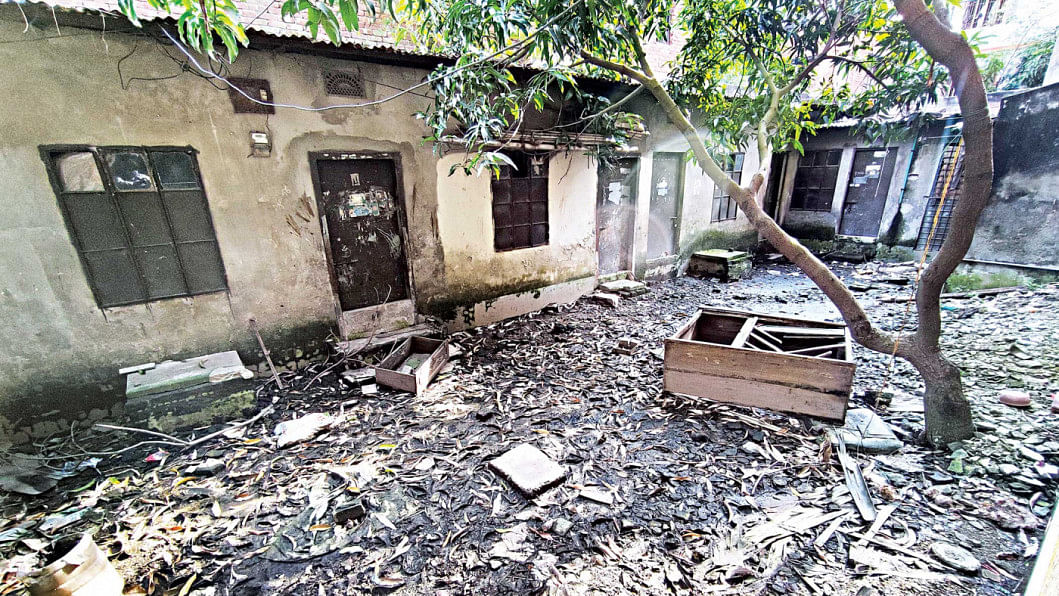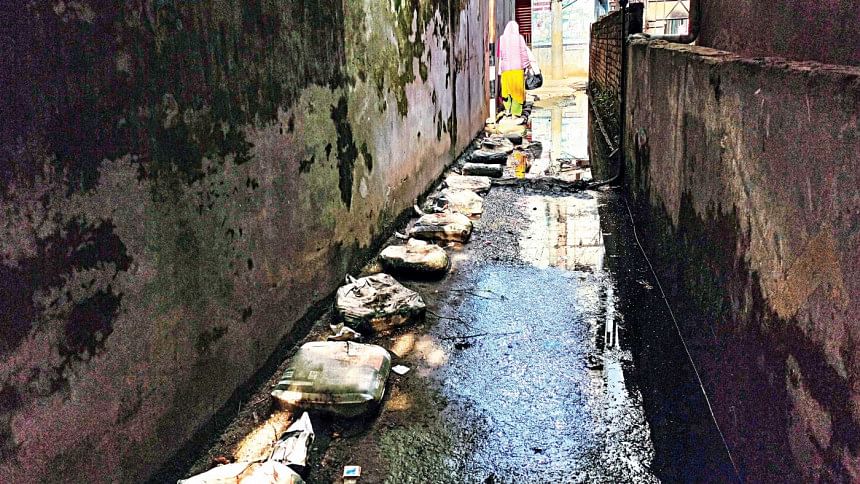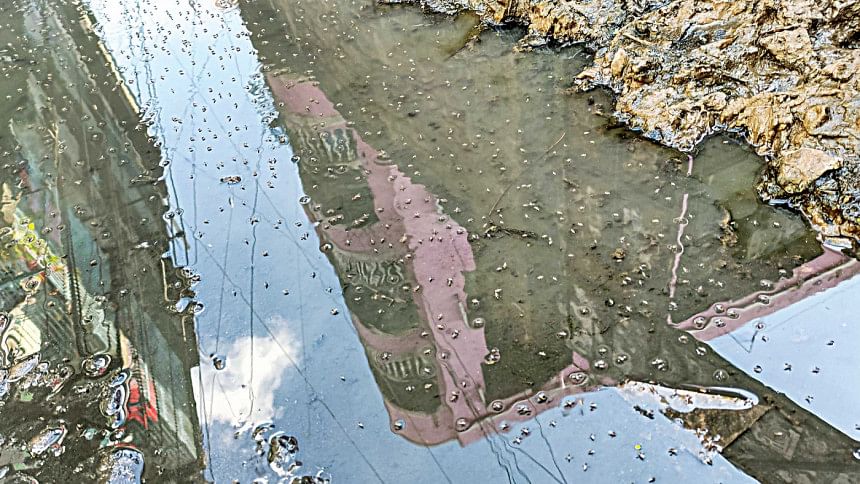Lost lives, abandoned homes: East Jurain hit hard by dengue, locals blame city corporation

Hafiza, a mother of two children from East Jurain's Khaja Mahbub Ali Road, has been suffering from dengue fever for more than 20 days. Her 12-year-old son, who was also infected, recently recovered after 13 days of a life or death struggle at a local hospital.
"I couldn't care for my son, as I'm also extremely sick. Doctors suggested we both get admitted to a hospital. But we couldn't afford that and decided to admit our son. He is still very weak and cannot eat at all," a weeping Hafiza told The Daily Star recently.

"Last year, my daughter got infected with typhoid. In 2019, my mother, who came to visit my place, also got infected with dengue and had to be admitted to a hospital. I asked my husband to move from this place, but we couldn't afford to rent a house in a better place," she added.
There are no tenants in the building next to Hafiza's. According to her husband Md Shultan, all the families moved after almost all of them got infected and two people died of dengue last month.
"One of them was Jishan, a boy of around 10. Jishan's parents went almost insane after losing their only child," said Shultan.
Md Mijanur Rahman, a permanent resident of East Jurain and a social worker, said, "Actually, you will not find any house along this road where there is not a single dengue patient at this moment. Many people have already left, and many are in the process of leaving this neighbourhood, as the disease is still spreading like wildfire."
"Those who are currently living here are either permanent residents or can't afford a better place to live," he added.

According to locals, most of the houses in East Jurain neighbourhood, which is under ward-53 of Dhaka South City Corporation (DSCC), have someone who is infected with dengue.
This correspondent visited at least 20 houses on East Jurain's Khaja Mahbub Ali Road, Commissioner's Road, Nurani Masjid Road, and at Shobujbagh and Khalpar areas recently, and he indeed found all the houses with at least one dengue patient.
DSCC does not have any data on the current number of dengue patients or deaths in the ward. However, during the visit, this correspondent learnt about the death of at least nine dengue patients just in August.
A REGULAR PHENOMENON
Severe outbreak of dengue infection and high prevalence of waterborne diseases every year has become a regular phenomenon in East Jurain.
And the reasons behind this annual epidemic is quite apparent if anyone visits the area.
Sewage water from a dilapidated sewerage system choked with solid waste overflowed the streets, creating stagnant pools here and there.
Besides, according to locals, one of the biggest reasons behind waterlogging in East Jurain is authorities increasing the height of roads in an unplanned manner.
As it is a low-lying area, DSCC has been heightening roads there for more than a decade, but without taking the height of adjacent buildings into consideration.
Many lanes such as Nurani Masjid Road and Commissioner's Road have been heightened up to 10 feet in the last five years.
As a result, bases of a large number of buildings in the entire area are actually lower than the heightened road, and so, these buildings get flooded quickly even after a rain shower.
According to DSCC, these roads will be further heightened up to five feet in the near future.
Local resident Md Ferdous said, "The ground and first floors have become unusable in most of the buildings in East Jurain due to unplanned heightening of roads by DSCC."
"After every drizzle, runaway water from these roads floods the ground floor and even the first floor, leaving them submerged for days, as we don't have any way to remove so much water. In these stagnant waters, mosquitoes breed in millions."
Due to continuous heightening of roads, many landlords have abandoned their buildings, as these structures have already become half-buried under the roads.
Large volumes of trapped rainwater with countless numbers of mosquitoes floating on top were seen inside these abandoned, ruined structures.
"We often purchase sand and earth to cover up the trapped water, but for how long can we do this at our own expense? Most of the families in this neighbourhood are very poor.
We also remove stagnant water from ground floors of the houses voluntarily, even though this hazard has been deliberately created by DSCC," said Ferdous.
"DSCC workers rarely visit this area to kill mosquitoes. They never took any initiative to clean up the sewerage line," he alleged.
"We even get filthy water at our homes, and we don't have gas supply for months. Meanwhile, DSCC is making the entire area unliveable by heightening roads in an unplanned manner.
They often say that our buildings are illegal structures, but they have issued holding numbers fort hem, and we pay holding tax regularly," said an agitated Ferdous.
WHAT AUTHORITIES SAY
Contacted, Meer Hossain Miru, councillor of ward-53, said DSCC's efforts to control mosquitoes is not sufficient.
"Due to manpower and resource constraints, DSCC workers cannot visit all parts of the neighbourhood regularly. So, we are focusing more on raising awareness, so that people themselves can maintain hygiene and cleanliness," he noted.
About unplanned road restoration, the councillor said, "I do not support such unplanned heightening of roads. Many people have lost their homes, businesses and income sources due to this road heightening project. This is also one of the reasons behind this deteriorating dengue situation."
However, DSCC has categorically denied the allegations of negligence and blamed the local inhabitants for building illegal structures and causing pollution.
Asked, Abu Naser, public relations officer of DSCC, said, "Our workers regularly visit all the wards to kill mosquitoes and clean up the potential breeding grounds."
"We have also asked locals to inform us about mosquito breeding sites through a hotline number, Messenger chat and by filling a simple form, which can be found in our website. Whenever we get information about mosquito breeding sites, our team goes there," added Naser.
Asked why the number of dengue patients is increasing in Jurain, Naser said, "The list we receive from the health ministry does not always mention address of the patients. So, our team cannot visit all the dengue affected areas. Again, there are some hospitals in Jurain that are treating such patients but do not report to the health ministry. As a result, we cannot get the actual number of dengue patients in Jurain."
"Also residents in Jurain are also not very aware of the hygienic habits they should maintain to prevent dengue. They throw plastic wastes into the sewerage system, which ultimately gets choked and sewage water overflows the streets," he commented.
On unplanned heightening of roads, one of the key reasons behind waterlogging in the area, Naser replied, "We are increasing the height of the roads, as the entire region is a low lying area. In fact, many buildings in this low lying area are illegal structures. So, we did not consider aligning our roads with those."
"Yes, we have issued them holding numbers, but these are illegal structures according Rajuk's building code. Getting a holding number does not mean that the structures are legal."
"However, we cannot deny that residents of Jurain are facing some problems due to lack of coordination among different agencies. To solve this issue, we have prepared a master-plan to re-organise the entire city in coordination with all the agencies, and we will start working soon according to this plan," stated the DSCC PRO.

 For all latest news, follow The Daily Star's Google News channel.
For all latest news, follow The Daily Star's Google News channel. 



Comments